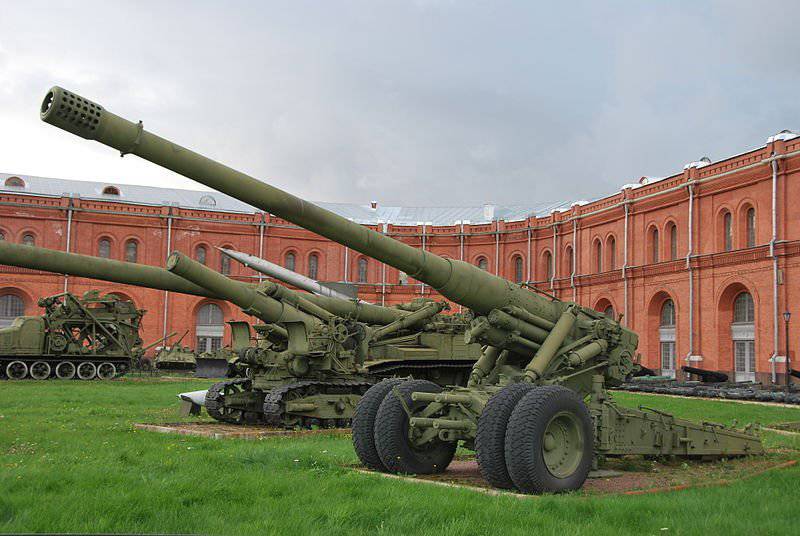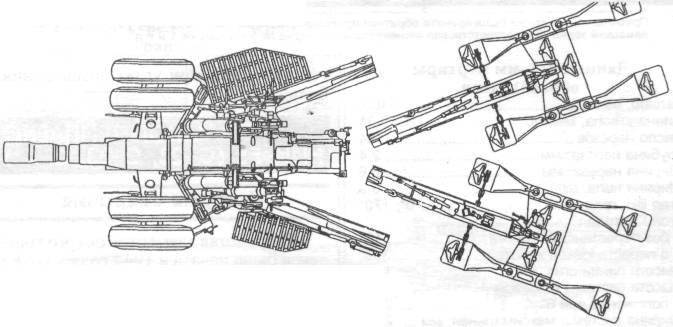180 mm C-23 gun (52-P-572)

C-23 is a heavy and bulky weapon; its combat weight is almost 21,5 thousand kg. The shape of the barrel, the length of which was 48 gauges, as well as the location of the recoil mechanism are indications of naval origin; The massive bolt has a screw mechanism, but the muzzle brake “salt shaker” is undoubtedly a land one. The shield is missing; the trunk is installed on a massive carriage having a sliding bed. Front during towing moves on a separate wheel pair; As a rule, a heavy tracked tractor is used for towing. During shooting, the wheels are hung out with the help of a jack lifting the pallet. The trunk C-23 in the stowed position is shifted back to the bed; The front slope has twin tires made from solid rubber.
The standard type of C-23 cannon is a high-explosive fragmentation projectile with a mass of 88 kg, of which 10 kg is an explosive. The maximum firing range when using this projectile is 30,4 thousand meters, but when using active-projectiles with a smaller explosive charge, the range of fire is up to 43,8 thousand meters. Among other types of ammunition used is a concrete-bombshell also other long-term structures. The C-23 cannon uses cartridges with propellant charges of different power.
The 180 mm C-23 gun, apparently, was not produced in significant quantities, and today it is almost completely removed from the armament of the armies of the CIS countries. The gun was once exported to India and Syria, but there is no exact information about whether it is available in Iraq.
The composition of the barrel of the gun included a free pipe, housing, coupling, breech and muzzle brake. Two-stroke piston shutter with a plate obturator. All operations with the gun, as well as actions with the bolt, were made manually.
Roll back spool hydraulic brake with variable rollback length, which depends on the angle of elevation. Knuckle hydropneumatic.
The lifting mechanism has two pointing speeds and one sector. Sector rotary mechanism, located on the upper machine, on the frontal box. The balancing mechanism is hydropneumatic.
When translating a gun into a combat position from a traveling wheel, they are hung out with the help of hydraulic jacks. The fire was carried out only with the coulter supports. Cushion supports consisted of two central and four lateral supports. For firing, the system was installed on a flat platform 8х8 m, if possible a platform with solid ground was chosen. In the case of installation of guns on soft ground, specials were used that were buried in the ground beams. The gun was mounted on the beam frontal box of the lower machine and fastened with chains to it.



Suspension of the front and rear torsion.
The forward gear in the fighting position is separated from the staninas and taken to the shelter along with the tractor.
Carriage gun with a barrel drawn, inseparable.
Sights: C-85 mechanical sight with a PG-IM gun panorama, MVSHP aiming tube used for direct aiming of the gun.
The plant “Barricades” during the year 1955 passed seven C-23. Issued guns, it was decided to leave in service, but further production ceased. Several times C-23 took part in parades on Red Square, causing not only the admiration of Muscovites, but also the surprise of military attaches from other countries.
180-millimeter C-23 was recalled in 1960-1970-s, and the Barricades plant began their export production. The C-23 guns, according to western press reports, were delivered to Syria and actively participated in the conflict in the Middle East.
At the factory "Barricades" at the direction of the Central Committee of the CPSU urgently started to restore the production of guns C-23. It was rather difficult to produce these works, as a significant part of those. documentation and equipment has been lost. Despite this, the plant team coped with this task, and by 1971 the 12 180-millimeter C-23 guns were manufactured. By these guns was developed and launched into mass production of an active-missile projectile OFNUMX having a range 23 thousand.
Performance characteristics of the 180 mm C-23 cannon:
Caliber - 180 millimeters;
Barrel length - 47,2 gauges (7170 mm);
Firing range:
high-explosive fragmentation projectile - 30390 m;
active-projectile - 43700 m;
Aim rate of fire - 0,5-1 shot per minute;
Angles of guidance:
horizontal guidance - 40 degrees;
vertical guidance - from -2 to + 50 degrees;
Charging - separate-sleeve;
Sights: gun panorama PG-1М, mechanical sight C-85, aiming tube MVSHP for direct fire;
Weight in the fighting position - 19750 (21450) kg;
The length of the short pullback - 700 mm;
The length of the long pullback - 1350 mm;
The maximum length of the rollback - 1440 mm;
The length in the stowed position - 10490 mm;
Width in the stowed position - 3025 mm;
The transition time from marching to martial status - 30 minutes;
Calculation - 14 (16) people;
Traction - tractor tracked AT-T;
Highway towing speed - up to 35 km / h;
Off-road towing speed - up to 12 km / h.
Ammunition:
- shot VF-572 having a high-explosive projectile F-572 (projectile mass - 88 kg, explosive mass - 10,7 kg, firing range - 30,39 km, initial speed - 860 m / s);
-GH-572 shot having a concrete-drilling projectile G-572;
- shot VO28 having an active-high-explosive high-explosive projectile OF43 (projectile mass - 84 kg, explosive mass - 5,616 kg, firing range - 43,7 km),
At the beginning of the 1970-ies were shipped to Egypt, India, Iraq, Syria and Somalia.
Information